Overview
The article focuses on seven essential dumbbell exercises specifically designed to strengthen the oblique muscles, which are crucial for core stability and overall athletic performance. It supports this by detailing each exercise's mechanics and benefits, emphasizing how these targeted movements enhance balance, coordination, and functional fitness, ultimately leading to improved posture and reduced injury risk.
Introduction
In the pursuit of a stronger, more resilient body, the significance of oblique muscles often goes unnoticed. Nestled along the sides of the abdomen, these muscles play a crucial role in core strength, stability, and overall athletic performance. As individuals strive to enhance their physical capabilities, understanding how to effectively target and strengthen the obliques can lead to remarkable improvements in balance, coordination, and functional fitness.
With a wealth of research highlighting the benefits of dedicated core training, it becomes clear that investing time in oblique exercises is not just about aesthetics; it's about empowering oneself to navigate daily challenges with confidence and agility.
This article delves into the vital role of obliques, offers practical exercise recommendations, and presents techniques to maximize results, ultimately paving the way for a healthier, more active lifestyle.
Understanding Oblique Muscles: The Key to Core Strength
Oblique muscles, located along the sides of the abdomen, are vital for building strength and stability in the torso. These dynamic muscles facilitate rotational movements, lateral flexion, and the maintenance of proper posture. Acknowledging the essential role of obliques is crucial, as a strong center not only offers support for the spine but also greatly improves athletic performance and enhances everyday activities.
Recent studies have indicated that fundamental training results in significant enhancements in balance and performance metrics. For instance, research indicates that the average relative thickness of central muscles was greater when using the hollowing maneuver compared to the bracing maneuver (p < 0.001), showcasing the effectiveness of targeted abdominal training techniques. Additionally, a case study titled 'Park, Hyun and Jee 2016' demonstrated that archery participants who underwent a 12-week training program focusing on balance experienced significant improvements in their performance tests.
By focusing on the reinforcement of side muscles, individuals can experience enhanced balance, coordination, and functional fitness. This not only empowers them to tackle daily tasks with greater ease but also supports their engagement in physical activities with newfound confidence. As Ioannis Tsartsapakis states, 'This study’s results provide partial support for the second hypothesis,' reinforcing the argument for the importance of targeted core training.
Therefore, investing in oblique activities can yield substantial benefits for overall athletic performance and functional capability.
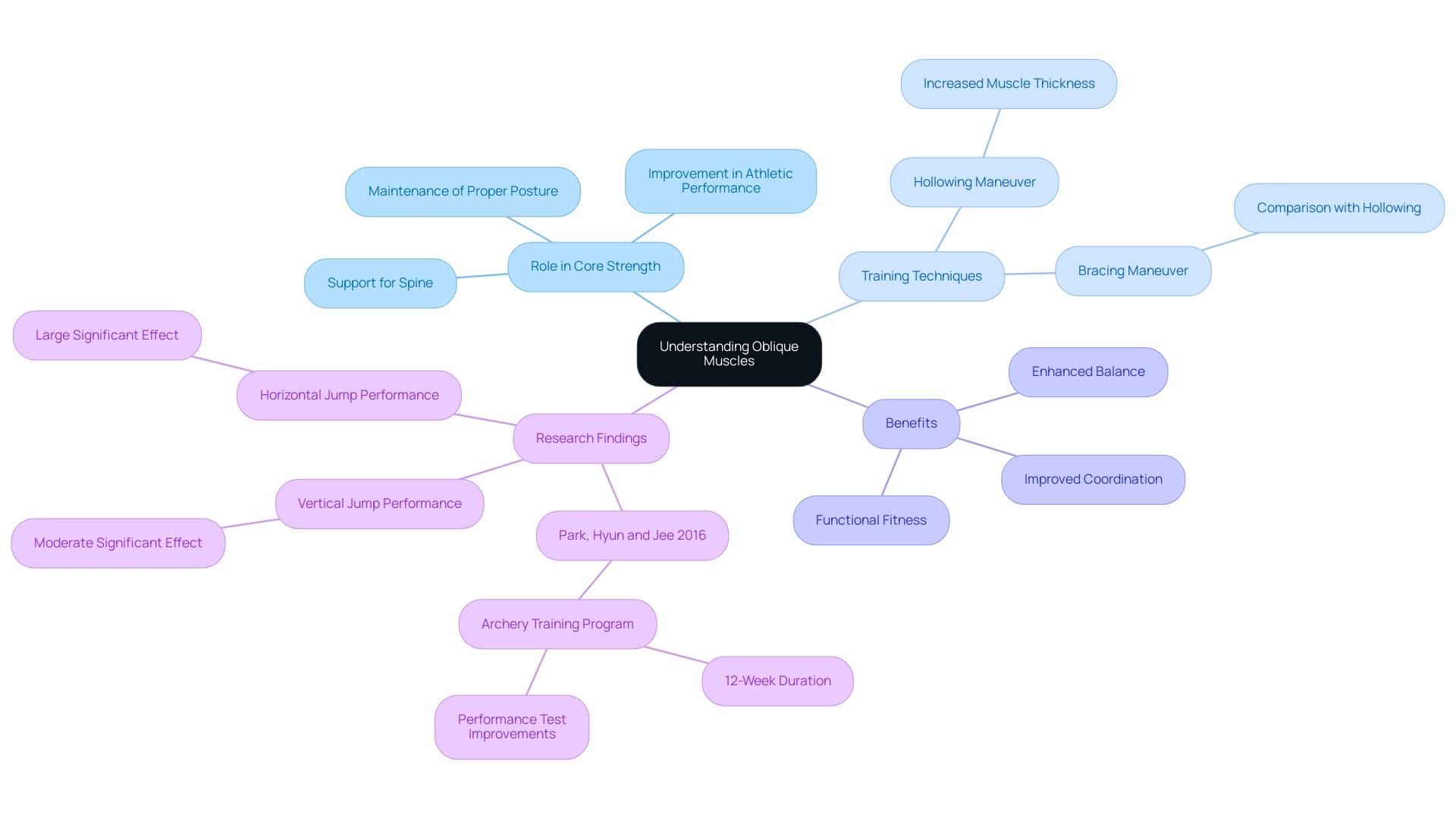
Top Dumbbell Exercises for Targeting Your Obliques
Here are some top dumbbell exercises specifically designed to target your obliques:
- Dumbbell Side Bend: Stand tall with your feet shoulder-width apart while holding a dumbbell in one hand. Gently lean to the lateral position, lowering the dumbbell towards your knee, then return to the starting position. This movement not only strengthens your side muscles but also enhances flexibility. Repeat on both flanks.
- Russian Twist: Sit on the floor with your knees bent and feet elevated, holding a dumbbell with both hands. Lean back slightly and rotate your torso from left to right, engaging your obliques throughout the movement. This exercise enhances core stability and balance.
- Dumbbell Woodchopper: Stand with your feet shoulder-width apart, gripping a dumbbell with both hands. Start from a high position above one shoulder and execute a chopping motion diagonally across your body to the opposite direction. Switch between both angles to engage the muscles efficiently. This dynamic movement mimics real-life functional movements.
- Dumbbell Plank with Rotation: Start in a plank position, holding a dumbbell in one hand. Rotate your body, lifting the dumbbell toward the ceiling while engaging your obliques. Alternate positions to maximize core engagement and strength. This exercise is excellent for building stability and coordination.
- Dumbbell Side Plank: Lie on your side with your elbow directly under your shoulder, holding a dumbbell in your top hand. Lift your hips to form a straight line from head to heels, effectively engaging your obliques. This powerful position develops strength and endurance in your center.
- Dumbbell Reverse Crunch: Lie on your back with a dumbbell held securely between your feet. Lift your legs towards the ceiling while curling your hips off the ground, concentrating on activating your abdominal muscles. This exercise targets the lower abs and helps develop overall core strength.
- Dumbbell Oblique Crunch: Lie on your flank, gripping a dumbbell in your top hand. Perform a side crunch by lifting your torso towards your hips while keeping the dumbbell extended overhead. This movement effectively targets the oblique muscles and encourages muscle development with dumbbell oblique exercises.
Integrating these activities into your fitness regimen can result in considerable enhancements in core strength and stability, aligning with recent trends that emphasize functional movements. As noted in the study by McGill & Marshall (2012), the greatest EMG activity was observed when adding instability with the BOSU during sit-up routines, underscoring the importance of incorporating varied movements for optimal results. Jeremy Ethier highlights that effective side muscle training necessitates movements that correspond with the diagonal alignment of side fibers, ensuring a thorough workout.
He states, "Therefore, we can then train and develop the side muscles in the most effective manner by ensuring two things in a workout for these muscles: Choosing activities that incorporate all the previously mentioned functions of the side muscles, and also work in line with the diagonal orientation that their fibers run." This approach not only enhances physical performance but also supports overall wellness, making it an essential practice for team well-being. Additionally, consider the Extended Side Angle Pose, which starts from a standing position with a wide stance, bending one knee into a lunge while twisting the torso and extending the opposite arm overhead.
This pose helps stretch the entire side of the body and can be intensified by placing the hand on a block or the floor instead of the knee, further enhancing the advantages of side training.
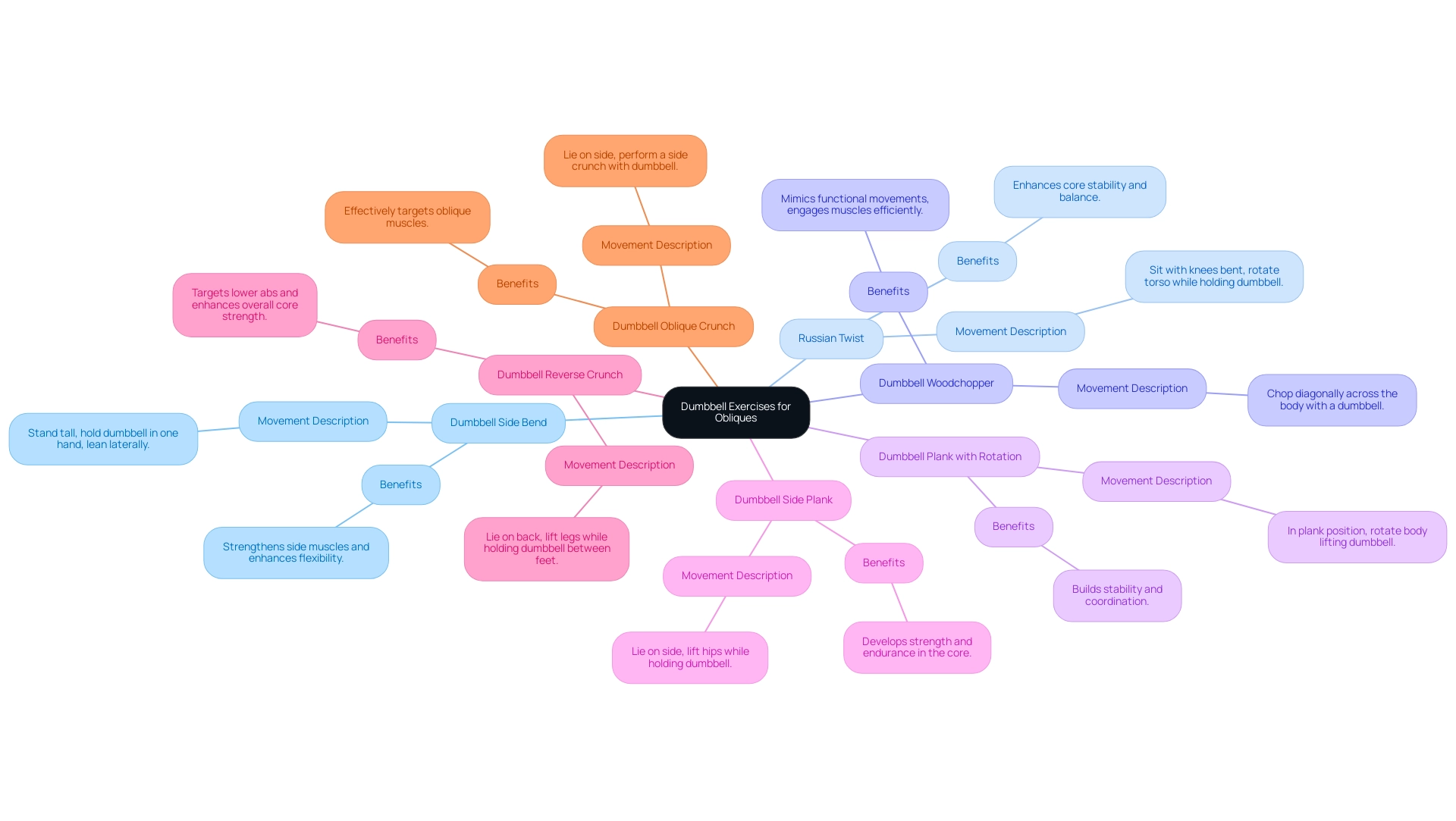
Mastering Form: Techniques and Modifications for Oblique Exercises
To optimize the advantages of your angled workouts and encourage central stability, consider these crucial methods and adjustments, which not only improve personal fitness but also lead to a healthier, more efficient workplace:
- Engage Your Center: Keeping your center activated is essential during every activity. This practice not only protects your lower back but also ensures that dumbbell oblique exercises effectively activate your obliques. As highlighted in recent studies, proper central engagement is vital for optimal performance, emphasizing the significance of central strength for movement efficiency.
- Controlled Movements: Emphasize slow, controlled movements throughout each activity. This approach minimizes the risk of injury while maximizing muscle engagement, allowing for a more effective workout. For example, activities like the bird dog and side plank, when performed with controlled movements, can significantly enhance core stability, and adding dumbbell oblique exercises can aid recovery from injuries and promote overall well-being.
- Breathing: Maintain proper oxygen flow by exhaling during the exertion phase—such as when lifting or twisting—and inhaling during the return phase. This technique is fundamental for sustaining energy and focus during your workout, which can translate into improved cognitive function and productivity at work.
- Modifications: For beginners, consider using lighter weights or performing movements without any weights until you gain confidence. Advanced practitioners can gradually increase weights to challenge themselves and enhance their training, ensuring everyone is engaged and supported in their fitness journey. Additionally, our customized app can assist in tracking progress and providing tailored recommendations, reinforcing the personalized attention aspect of our wellness programs.
- Listen to Your Body: Always prioritize safety and comfort. If you feel pain or discomfort, take a moment to reassess your form. Listening to your body is essential for a sustainable and effective fitness journey, fostering an environment of care and support within your team.
By integrating these techniques into your routine, you can reinforce a culture of health and wellness, ultimately making a significant impact on your team's productivity and performance. Investing in your team's health not only enhances individual well-being but also contributes to overall firm success by reducing burnout and improving job performance.
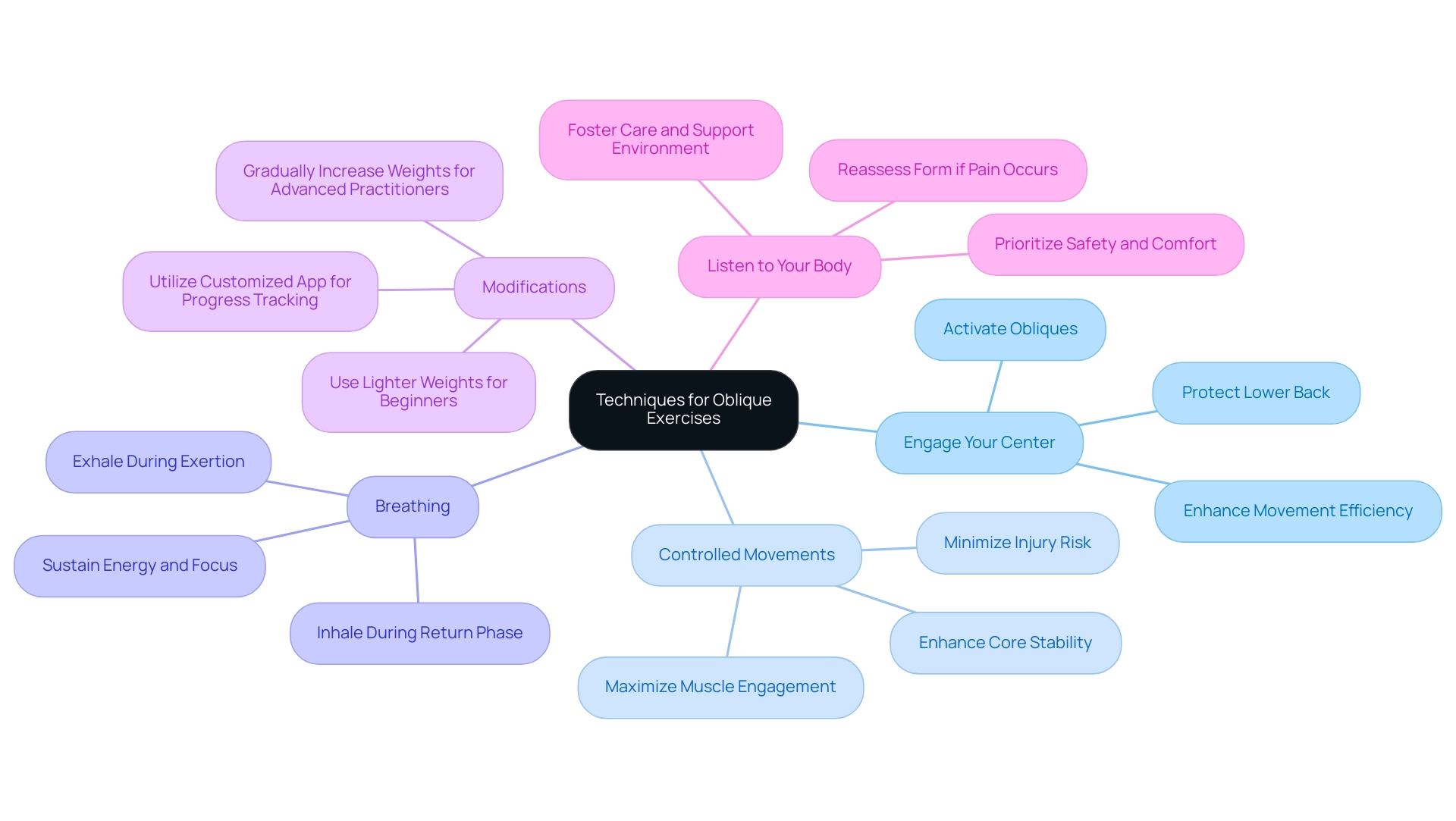
The Benefits of Strengthening Your Obliques
Including angled exercises in your fitness routine is not merely a choice; it’s a significant investment in overall health and well-being. Here are some compelling benefits that highlight why strengthening your side muscles is essential:
- Improved Core Stability: Strong side muscles are crucial for maintaining balance and stability, which enhances athletic performance and supports daily activities. Physical therapists emphasize that a stable center reduces the risk of falls and enhances movement efficiency. Importantly, back extension movements show considerable activation levels, with ~63% MVIC on the floor and ~56% MVIC on the bench, highlighting the significance of stability in performing dumbbell oblique exercises to train the sides of the abdomen.
- Improved Posture: Strengthening your lateral muscles plays a crucial role in spinal support, aiding in better posture and reducing back pain. Real-world examples show that individuals who participate in regular angled training report significant improvements in their posture, leading to increased confidence. Furthermore, the efficacy of activities such as the single-legged back extension, which triggered greater muscle engagement than dual-legged alternatives, emphasizes the significance of focused lateral training.
- Injury Prevention: Performing dumbbell oblique exercises helps develop a strong midsection, which is crucial for providing support during physical pursuits and effectively safeguarding against injuries. Research indicates that concentrating on fundamental stability through dumbbell oblique exercises can result in a reduction of sports-related injuries, with lateral strength being an important factor. The deadlift, for instance, demonstrates ~90% MVIC activation for barbell variations and ~80% for hex bar deadlifts, offering a comparative view on the effectiveness of different abdominal workouts.
- Increased Functional Strength: The strength gained from lateral workouts, such as dumbbell oblique exercises, directly translates into enhanced performance in sports and various physical activities, empowering individuals to achieve greater power and efficiency.
- Better Aesthetics: A well-defined midsection is often associated with a toned, aesthetically pleasing appearance. Strengthening your side muscles not only boosts physical capability but also enhances self-esteem and confidence.
As Mr. Hiroshi Kimura wisely notes in his contributions to the field,
The benefits of core stability extend beyond performance; they are fundamental to injury prevention and overall wellness.
Investing in angled workouts is a step toward a healthier, more resilient future.
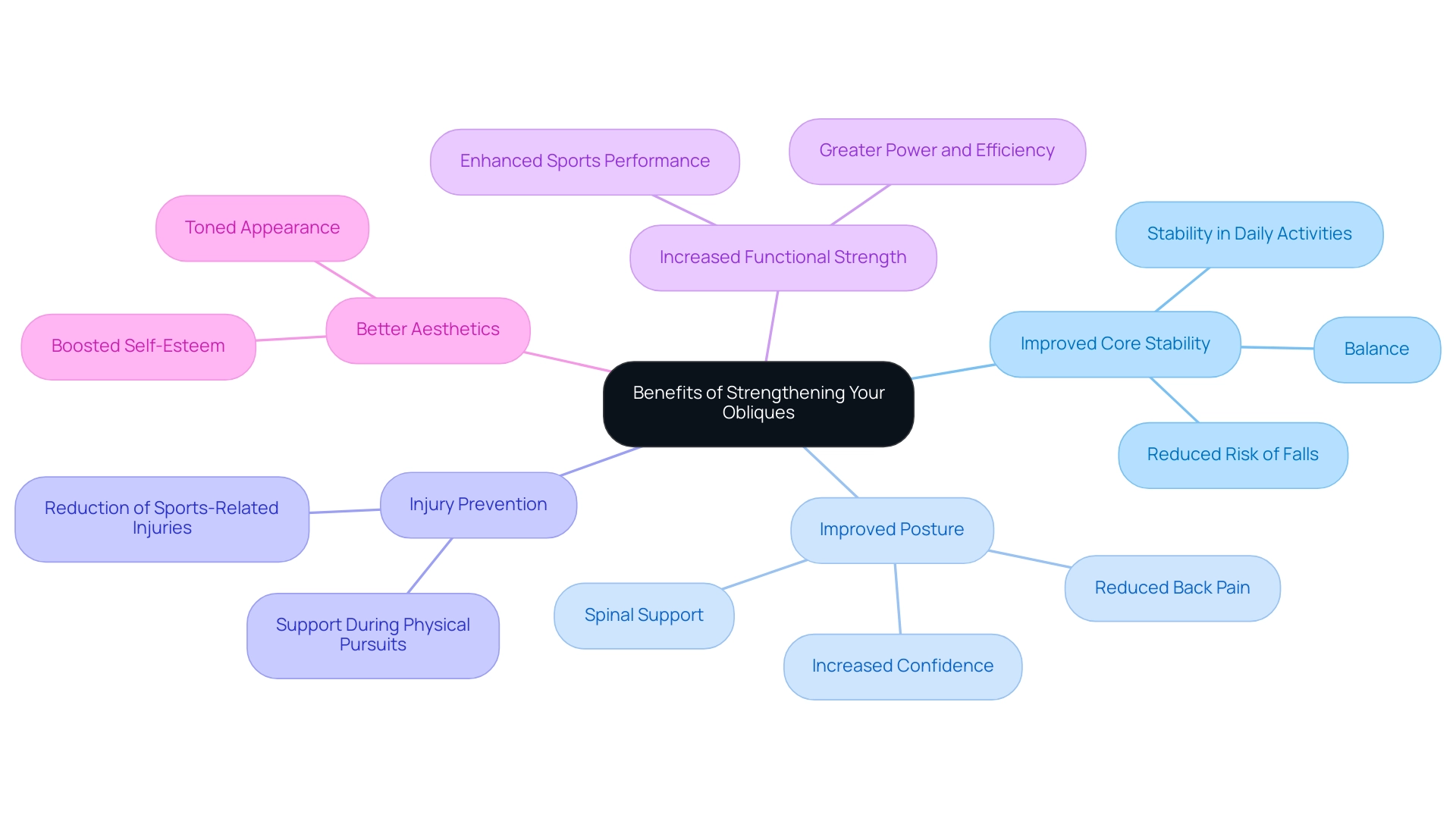
Incorporating Oblique Exercises into Your Workout Routine
To effectively incorporate angled movements into your workout routine, consider these empowering strategies:
- Frequency: Aim to participate in angled activities 2-3 times a week, ensuring sufficient recovery time between sessions to optimize muscle growth and strength. Shahril, who managed to completely transform his body in just 9 months on the program, exemplifies the positive results that consistent training can yield.
- Warm-Up: Kick off each workout with a dynamic warm-up. This prepares your muscles for action and significantly lowers the risk of injury, setting you up for success.
- Progression: Begin with lighter weights, focusing on perfecting your form first. Gradually increase the weight or complexity of the activities as you gain confidence and strength, allowing for continuous improvement. Notably, Arazi and Asadi observed a pre- vs post-intervention strength difference of 5.0 kg (10.6% change), underscoring the benefits of progressive overload in your routine.
- Combination Workouts: Integrate dumbbell oblique exercises into full-body routines or core-focused workouts. This not only maximizes efficiency but also enhances overall results, making your training more effective.
- Listen to Your Body: Pay close attention to how your body responds to each exercise. Adjust the frequency and intensity as needed to maintain progress while preventing burnout. Remember, fitness is a journey, and being in tune with your body's needs is key to long-term success. Additionally, it's important to recognize the methodological limitations in core muscle research that call for standardized methods in measuring effectiveness, ensuring that your training is both effective and scientifically grounded.
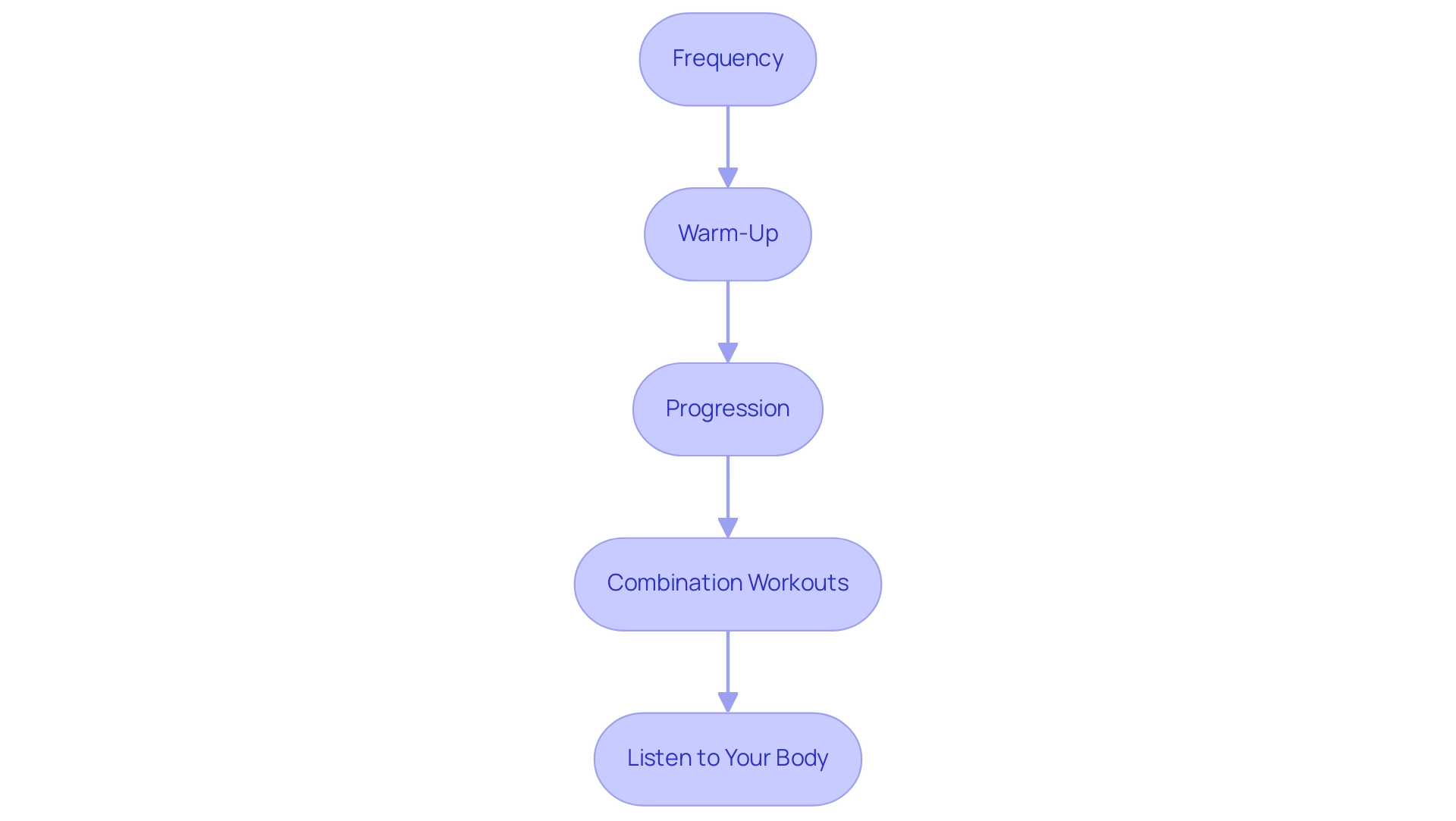
Conclusion
Strengthening the oblique muscles is a transformative investment that goes far beyond physical aesthetics. By incorporating targeted exercises into a regular fitness routine, individuals can significantly enhance core stability, improve posture, and reduce the risk of injuries. These benefits not only empower individuals in their athletic pursuits but also translate into greater ease in daily activities, fostering a more active and confident lifestyle.
Engaging in exercises such as:
- Dumbbell side bends
- Russian twists
- Woodchoppers
can lead to remarkable improvements in balance and functional fitness. As the research highlights, consistent training of the obliques is crucial for maximizing athletic performance and overall well-being. The importance of proper technique and form cannot be overstated, as they ensure effective muscle engagement while minimizing the risk of injury.
Ultimately, prioritizing oblique training is an essential component of a holistic approach to fitness. By embracing these exercises, individuals can cultivate resilience not only in their bodies but also in their everyday lives. Now is the time to take action and invest in a stronger core, paving the way for enhanced performance and a healthier future.
Frequently Asked Questions
What are oblique muscles and why are they important?
Oblique muscles are located along the sides of the abdomen and are essential for building strength and stability in the torso. They facilitate rotational movements, lateral flexion, and help maintain proper posture, which supports the spine and enhances athletic performance and everyday activities.
What benefits does training the oblique muscles provide?
Training the oblique muscles enhances balance, coordination, and functional fitness, allowing individuals to perform daily tasks more easily and engage in physical activities with greater confidence.
What research supports the importance of oblique muscle training?
Recent studies indicate that targeted abdominal training techniques, such as the hollowing maneuver, lead to greater muscle thickness compared to other techniques. Additionally, a case study showed that archery participants who underwent a 12-week balance-focused training program experienced significant performance improvements.
Can you list some effective dumbbell exercises for targeting obliques?
Yes, here are some effective dumbbell exercises: 1. Dumbbell Side Bend: Strengthens side muscles and enhances flexibility. 2. Russian Twist: Improves core stability and balance. 3. Dumbbell Woodchopper: Engages muscles through a chopping motion. 4. Dumbbell Plank with Rotation: Builds stability and coordination. 5. Dumbbell Side Plank: Develops strength and endurance in the center. 6. Dumbbell Reverse Crunch: Targets lower abs and overall core strength. 7. Dumbbell Oblique Crunch: Effectively targets oblique muscles.
How can integrating oblique exercises into a fitness regimen benefit an individual?
Integrating oblique exercises can significantly enhance core strength and stability, aligning with trends that emphasize functional movements. This not only improves physical performance but also supports overall wellness.
What is a recommended yoga pose for oblique training?
The Extended Side Angle Pose is recommended, where one starts from a standing position with a wide stance, bends one knee into a lunge, twists the torso, and extends the opposite arm overhead. This pose stretches the entire side of the body and can be intensified by adjusting hand placement.

